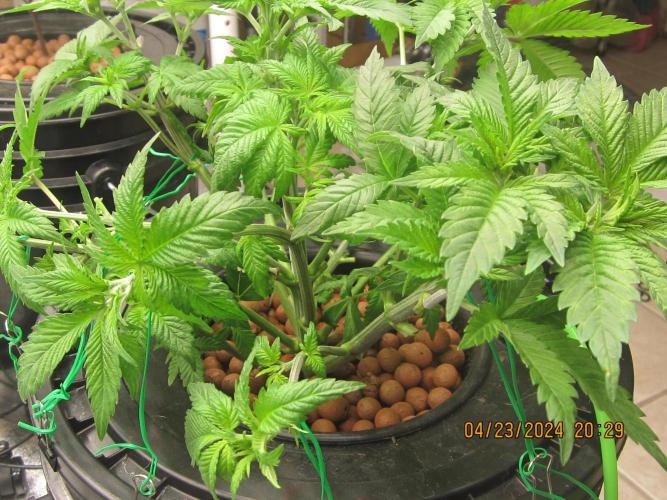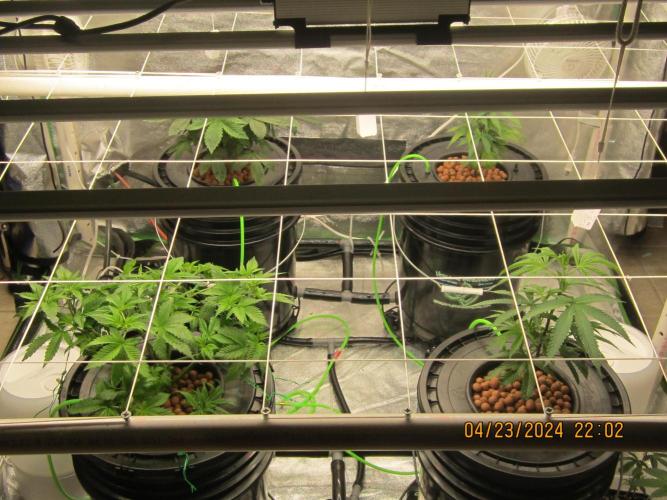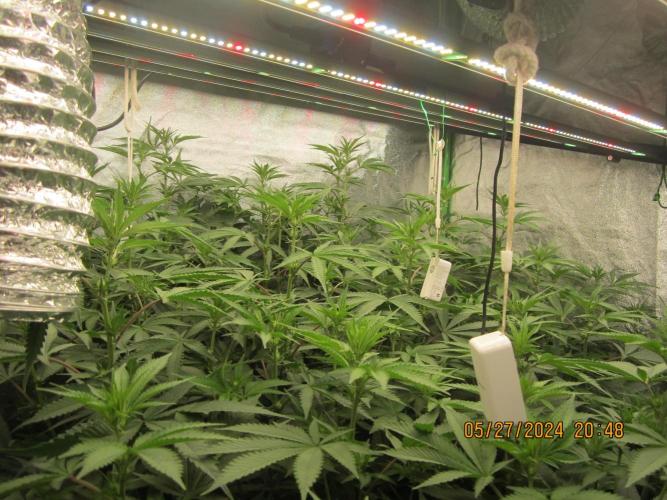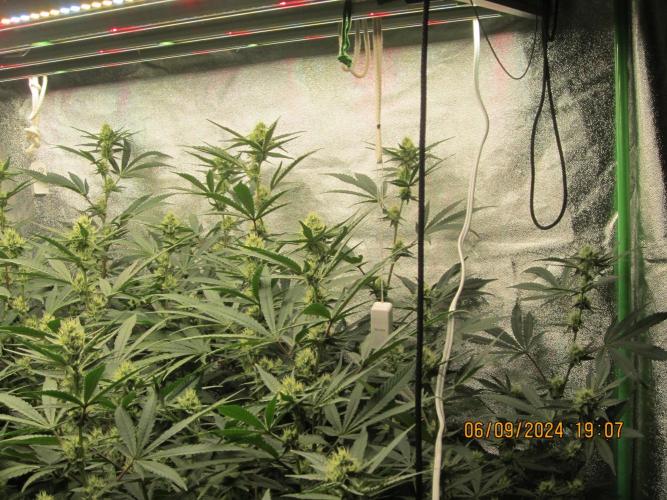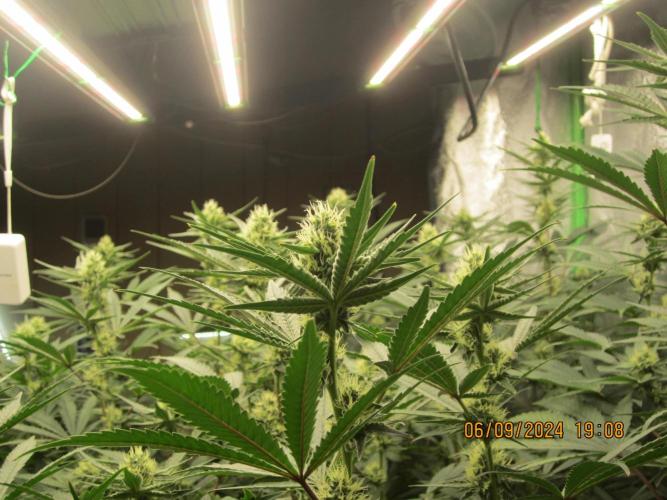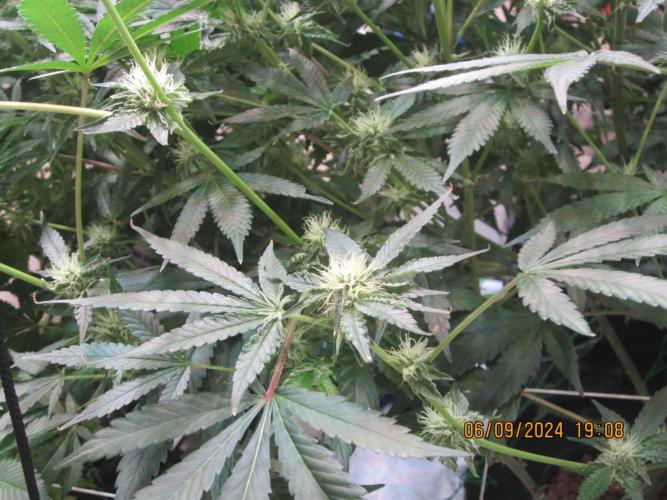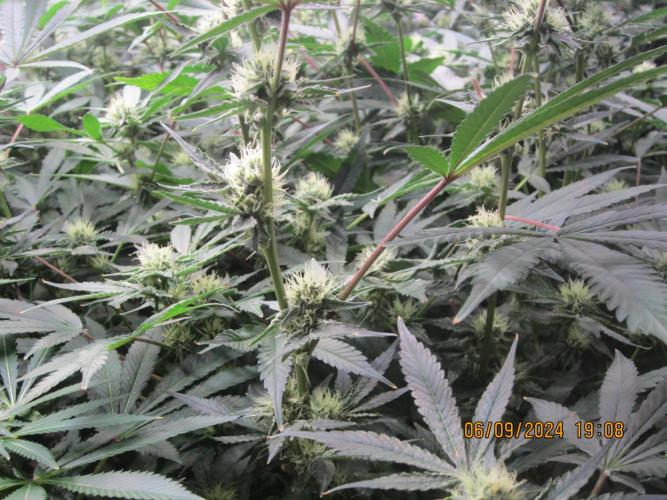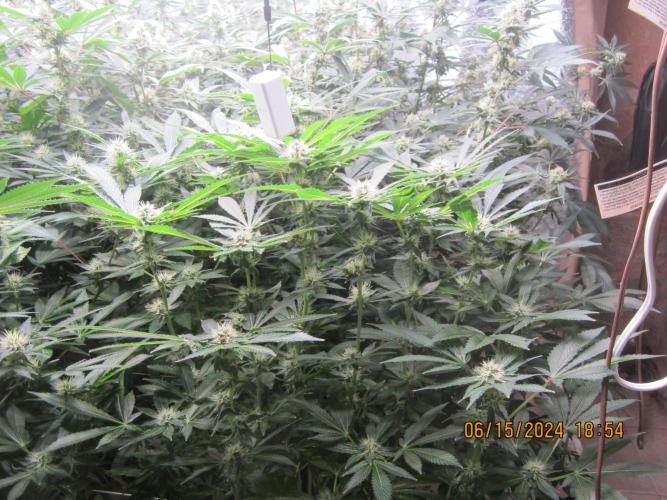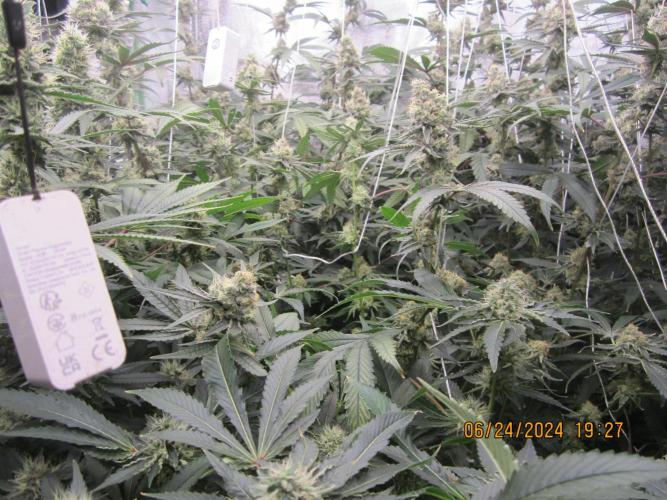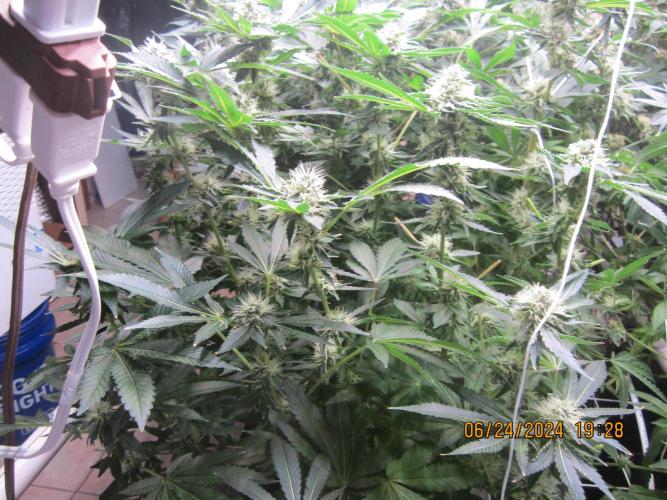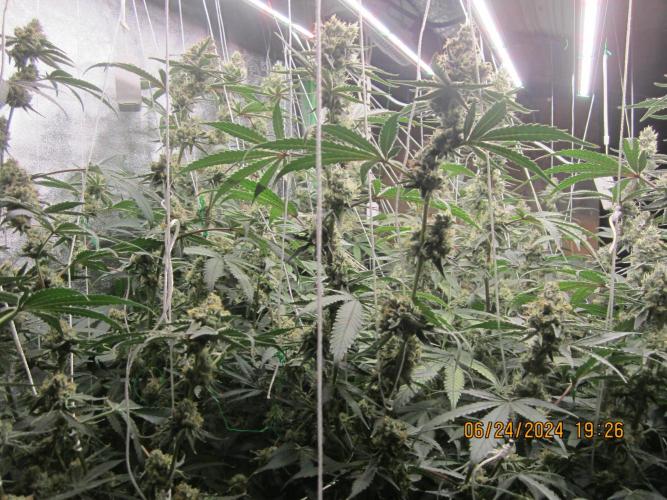The Grow Awards 2026 🏆 



Purple Queen Hydroponic Grow

VEG
Custom Light Emitting Diodes/685W
Custom

Tent
5 x 5 Budgrower
5 x 5 Budgrower
Expanded Clay
Custom
Indoor
Room Type
LST
weeks 2, 6-7
ScrOG
weeks 6
Topping
weeks 6-7
Defoliation
weeks 6-7
SoG
weeks 7
72 liters
Pot Size
Start at 14 Week
G
Germination2y ago
ProGuyMJ 3/10
I've got a good room in a cool spot. 12' x 12' with attached closet and bathroom. The space is dedicated. In that space, I have a 5' x 5' tent with a high canopy. I have a Flexseries 5 LED, 685W. I have set up a 4 bucket hydroponic RDWC system. I have installed 3/4" return lines and a 1/2" pump driven input from reservoir to bucket. Each bucket has a bottom drain going to an inline pump.
I have not hooked up the cooler as of yet. Temperatures are low now. I have an external 41 gallon reservoir for mixing to transfer into the system reservoir. It is fed by a RO system that is pushing 80PSI with no issues. Current water fills at 5.5PH and maintains 0 PPM, EC, and TDS. I have an aquarium pump to circulate the reservoir with a 100W heater, maintaining 75 degrees F.
System has been cleaned with hydrogen peroxide and bucket nets contain clay pellets.
I started germinating 5 Purple Queen, feminized seeds at 2:00 this afternoon. (NOTE: tonight is DST). Seeds are in closet that is at 54% humidity and steady at 83 degrees F. Seeds are in a small propagator, under a small LED seed lamp. Heat in propagator is steady at 84 degrees F. Humidity is 88%. Small Rockwool cubes were socked and drained to hold 55ml of clean RO water at 5.5PH, each. Vents are closed and all seems well.
3/14
The setting for # or # of seeds above ... does not work.
I am using a small LED seed lamp (EDIT) and germinating the seeds in a small closet. The temperature with the lamp on (18 hours) and at 18" from the surface of the top of the propagator is around, 26C. With the lamp off (6 hours) and with a cotton towel folded to three layers, the temperature maintains at 26C. Perfect! 😁
Also, I measured the ml of water in the rockwool cubes by tare weighting the whole mess before watering. From my research, it seemed that aiming at 50ml per cube was appropriate. To maintain the water level here, I just added water to each cube after confirming they had dehydrated at the same rate.
Water added was a 5.5ph
No nutrients
GOVEE temp/humidity monitor in propagator
3 of the 5 seeds have pushed passed the wool. 1 more is evident and the last, I hope tomorrow.
2 likes
3 comments
Share
Used method
Rockwool Cube
Germination Method
Grow Questions
ProGuyMJstarted grow question 2y ago
I am using General Hydroponics, hydrobloom, ryzofuel, CalMag ... and unsure of the right mix to get this rolling after the seeds germinate. Also, as I mix for subsequent topping off, which of these nutrients should be increased/decreased over time.
Open
likes
Answer
SkunkleDamoanswered grow question 2y ago
Hi there you are best to look at the general hydroponics feed chart that will be in the bottles, website etc.
Once they germinate they won’t need any nutrients for a few days and when you start using the nutrients it is best to start at a greatly reduced rate
likes
Complain
LSchnabelanswered grow question 2y ago
General Hydroponics has a feed schedule on their website for all their nutrients. You can print out the feed schedule and use that as a basis point. They break it up into a Light, Medium and Heavy feeding. I use general hydroponics as well and stick with the light feedings till week 4 then go to medium feedings.
For seeds in soil I only used CalMagic for the first week, second week they got their first dose of nutrients at a light feed. Also, I only feed once per week.
It’s best to get a nice TDS meter so you know exactly what you are mixing up so you are not too heavy or too light. An entry level one will run -50.
Hope this helps
likes
Complain
ProGuyMJstarted grow question 2y ago
Temperatures overnight with the LED were higher than expected. (82.3F). Lights off at 8:30AM, maintained -78F duration of lights out. Lights are now on and the door ajar. Did having the higher temperature for 18 hours negatively affect the seeds?
Open
likes
Answer
LSchnabelanswered grow question 2y ago
Not at all my friend. In fact recommended germination temperatures are 70-85 degrees.
Would it be best to keep a more steady temp, yes, but you are well within acceptable ranges.
Good luck and hopefully we see some sprouts in your diary soon!
Hope this helps.
likes
Complain
ProGuyMJstarted grow question 2y ago
When moving the rockwool cubes to the clay pebbles ...
Does the wrap come off the cube?
Open
likes
Answer
LSchnabelanswered grow question 2y ago
I have always removed the wrap. I don’t know if it makes too much of a difference but it just felt right doing it so many years ago that I always have done it.
I hope this helps.
likes
Complain
ProGuyMJstarted grow question 2y ago
Who has experience with using LUX meters to position lights in various stages of hydroponic growth. I feel I am giving mine too much light, based on the readings, but don't want to pull them back. Currently 10" from the plants.
Solved
Setup. Lighting
likes
Sit_Ubu_Sit_Good_Doganswered grow question 2y ago
If you take notes of the lux values relative to each "type" of light.. it's very useful. If the CCT and other properties are the same, then the values can be re-used under different equipment with those same specs. Otherwise, you'd want to take new measurements and similar trial and error of finding what gives the resulting "optimal" growth pattern for your environement. No matter how you measure this, you need to observe the plant and adjust to what you see and not some theoretical target DLI that is only meant as a ballpark idea and not an exact answer.
It's the same exact systematic process you'd need to take with a "quantum meter" that accurately measures photons/s of PAR. The initial starting point will be more informed with a quantum meter, but you still have to go through a trial and error process to find optimal hours of operate (a commonly overlooked tool of manipulation) x intensity of light (PPFD and resulting DLI) with good distribution across your canopy. But even this isn't a huge difference because some common sense range of hanging distance is going to put you in a good starting spot anyway.
Consider impace of how light spreads out very quickly, therefore it increasingly loses intensity in any 1 spot the further it is away from the light source. So, a power/hangingdistance/hours of operation combo that results in the lights being very close to the plants is find for smaller, younger plants. Except in extreme cases of diodes perfectly distiributed relative to growing area, A combo of those facters that require a bit more distance from the canopy will give better light penetration -- a complete waste early on with young plants. But once you figure it out for one context, the same lux values at canopy can be used in later life stage contexts - even if going from 18hours to 12hours.
usually with a qb you need 18-24" to properly cover the footprint that 100% power and 12hours opeartion (for photoperiods, or longer for autos). "Bar" style lights can often get much closer. Working backward from your ending canopy size and distributing light to edges and corners is more about geometry - take measurements all over the place and make sure the deviation from central area to edges is reduced to acceptable levels. Start here for obvious reason. Then find the resulting power from light x hours of operation that give you the best growth.
the proportions will remain the same.. if the corner is 60% of middle, it'll be 60% of middle whether you have the light at 100% or 50%. This is why the lux readings have the integrity of a 500 usd quantum meter's readings of umol/s of PAR. You'd also see a 60% reading in corner compared to central area with the quantum meter. it is 1:1 proportional in this way.
the drawback to lux readings is that light with different properties will read different values for the same umol/s of PAR. umol/s of PAR is what the plant cares about and nothing else. Resulting DLI is what matters underneath. So, if you use different equipment, you may notice slight differences as to max lux you can give to canopy, but underneath it'll still be a similar umol/s of PAR (PPF) and DLI (ppfd x hours of operation, simlpy).
Read wiki on Daily Light Integral (DLI). Get the gist of it. You dont need to memorize the math.
going back to above how once you figure out a good luz value at canopy and hours of operation in vege phase can be translated to a 12 hour cycle without re-measuring anything. inversely proportional to the change in hours of operation you need a boost to power. so 18 down to 12 needs 150% more power, or lux. ( x 18/12 or 3/2 or 150%) In the end the same DLI is the goal, and it is proportional in this way to hours of operation.
Light's dimming power is usually also mostly 1:1 but not something you can assume, but if the plants react the same, that is confirmation. (see examples of this in cocoforcannabis light model reviews.. you see the umol/s output is mostly proportional to the percent power of the light dimmer, though not perfect.
learning the math from the wiki and using your light's spec sheet in conjunction with a lux meter is going to be pound for pound just as good and just as easy to optimize as a quantum meter. it jsut takes a bit more effort on your part. And half assing it is still very useful along with trial and error, as stated above.
this looks like a lot.. but it's quite simple and should be common sense deductive processes to reach a goal vs anything that needs to be re-read. learn the definitions and how to perceive light and plants absorption of it. then it's just common sense from there.
i'd defnitely trust a lux meter over a phone app, but the important thing to this process is that the readings are consistent, which they are. It doesn't matter if your trial and error leds you to a reading of 25k or 60klux or 900 PPF over 12 hours. What matters is that specific level of light is always "60klux", which it will be under that same exact model of light (or same exact light properties). The apps and camera lenses give inflated values by comparison, but it'll be inflated in the same exact way each time. the cheap lux meters are more directional in the light it captures - i believe is the cause for deviation. it is mechanical in nature.
1
Week 1. Vegetation2y ago
8 cm
Height
18 hrs
Light Schedule
27 °C
Day Air Temp
5.8
pH
No Smell
Smell
250 PPM
TDS
65 %
Air Humidity
22 °C
Solution Temp
18 °C
Night Air Temp
18.93 liters
Pot Size
70 cm
Lamp Distance
ProGuyMJ I lost ground and had low success with my Royal Seeds, Purple Queen. That said, two are doing well and I've ordered 2 clones to fill out the tent. I've been holding temperatures in the water to 72 degrees without the chiller. The air temperature in the room has been running close to 80 degrees. I think both are too hot. I'm pulling a higher rate on the inline fan and I am aiming for 78 in the tent and 68 in the water. I will put the chiller in when I change the nutrient solution tomorrow.
1 like
comments
Share
Grow Questions
ProGuyMJstarted grow question 2y ago
I am adding 2 clones to fill out my tent. I will change to water tomorrow. The 2 Purple Queens are entering their 3 week and the nutrient mix will turn up a notch. What mix would you recommend for the nutrients? Is there a nutrient to add in this unique situation?
Open
likes
Answer
Sit_Ubu_Sit_Good_Doganswered grow question 2y ago
both in vege? it's old enough? the same formula is fine.
There's not really at ime a plantn all of a sudden needs 1 thing. you should be providing it at all times - a well-balanced diet. sometimes you need a shift in flower with a bit less N.. maybe 10-15% less depending on how heavily you fed it in vege.
think about humans.. one day a year do they need a spike in calcium? no, that's crazy. The body needs a certain amount of everything, every day. plants are even simpler.
also assuming 'clones' means rooted cuttings and not 'cuttings' with no roots. A vege plant is a vege plant is a rose is a rose.
likes
Complain
Tommy716answered grow question 2y ago
With clones, I typically use clonex by grow technology. It works amazing and dynamo microbials and that's it in the beginning. After about a week or so after transplant, I go to about 1/5 of tip of my normal vegetative nutrients.
likes
Complain
Organomananswered grow question 2y ago
Clones should be fine with your "seedling" mix.
likes
Complain
2
Week 2. Vegetation2y ago
9 cm
Height
18 hrs
Light Schedule
23 °C
Day Air Temp
5.8
pH
No Smell
Smell
480 PPM
TDS
72 %
Air Humidity
21 °C
Solution Temp
18 °C
Night Air Temp
18.93 liters
Pot Size
30 cm
Lamp Distance
ProGuyMJ It took me awhile to get back to this. I experienced extreme failure on my seeds and only two of the Purple Queens survived. I added 2 clones to the mix so the space would not be lost. I have added 2 Gelonade clones and with an initial sputter, they are now off to the races as well.
I am going to back track the diary with some pictures and commentary here.
I LOVE HYDROPONICS
Without a doubt, this is the cleanest and most professional type of setup I could have conceived. The biggest worry is how dependent I am on the power grid. That said, I bought a decent generator, just in case.
In fact I bought a lot of decent things to get this going. The initial sticker shock is substantial. However, I looked around a love a second hand deal. The equipment here could have cost me 00, but I pulled it off for about 1/2.
The results speak for themselves!
This week I kept things light on plants. I did not increase the nutrient solution and just let everything flow together. I was being conservative with the light intensity at this point.
The clones took well and the Queens root systems were strong.
likes
comments
Share
Used techniques
LST
Technique
3
Week 3. Vegetation2y ago
18.5 cm
Height
18 hrs
Light Schedule
23 °C
Day Air Temp
5.8
pH
No Smell
Smell
720 PPM
TDS
72 %
Air Humidity
21 °C
Solution Temp
18 °C
Night Air Temp
18.93 liters
Pot Size
25 cm
Lamp Distance
ProGuyMJ Everything is going strong. The plants are uneven and that presents no challenge yet. I'm looking to veg these for another 3 to 4 weeks in an effort for balance. I topped these during this week. Huge water droplets came from each cut. Along with the topping I cut back a lot. The Purple Queens sprout like broccoli and are very tight to the center. After cutting back we use clips on the buckets to spread the canopy.😀
likes
comments
Share
4
Week 4. Vegetation2y ago
24 cm
Height
18 hrs
Light Schedule
23 °C
Day Air Temp
5.8
pH
No Smell
Smell
810 PPM
TDS
72 %
Air Humidity
21 °C
Solution Temp
18 °C
Night Air Temp
18.93 liters
Pot Size
23 cm
Lamp Distance
ProGuyMJ WOW
These girls are doing great. I can hardly keep up with their progress. One more posting and we'll get back on track for some daily updates. I have found it imperative to take pictures everyday. Even on days when I'm barely paying attention. These pictures help keep it all in perspective and do add context to the narrative.
Purple Queens grow very thick. Leaves are beautiful, big and broad. Every inch of both the PQs looks ready to burst. Many main colas sights evident and topping is easy.
I have installed the net in anticipation of grabbing these. Because the buckets offer no way in without lifting the top, I remain cognizant and positioned the net to allow observation under the lid. I would prefer the Stor rectangular buckets for the hatch on each lid.
The Gelonade clones have caught up. They are not nearly as bushy but have lots of cola sites. I've topped these also and will do again next week.
I also moved one Purple Queen to the front spot. Both the Queen and Gelonade liked the switch. Light is a little more intense in the back with the Gelonades now. More airflow in the open front. Trying to note what is different and why these strains react positively in opposite directions.
likes
comments
Share
5
Week 5. Vegetation2y ago
30 cm
Height
18 hrs
Light Schedule
23 °C
Day Air Temp
5.8
pH
No Smell
Smell
570 PPM
TDS
72 %
Air Humidity
21 °C
Solution Temp
18 °C
Night Air Temp
18.93 liters
Pot Size
23 cm
Lamp Distance
ProGuyMJ FINALLY CAUGHT UP
Rough start, feeling good about the progress.
These plants (two strains) are tight and compact.
They are uneven. PQs 10"/13" {{{}}}} GN 13"/16"
Utilizing dual humidifiers and holding humidity about 70%. I often push that up to the 90%+ and allow the whole tent to wallow in the moisture. These plants are showing no signs of mold or humidity related rots. The chiller keeps the system water between 69 and 71 degrees F.
I have 8 small fans in the tent. I use them to create a cyclone effect. I will be adding a controller so I can slow the speed and flow to prevent a hurricane. It can get intense. Also running a pretty cheap inline fan with Vortex as backup.
I have two cuttings that rooted well in soil. It was a very successful experiment and I'll find a hillside for them where I can give it a shot. I do not want the soil in the tent.
No sign of root rot ... very healthy roots.
Trimming again now ... more photos to come.
Will add nutrient to bring PPM back up.
More topping ????
likes
comments
Share
6
Week 6. Vegetation2y ago
42 cm
Height
18 hrs
Light Schedule
22 °C
Day Air Temp
5.8
pH
Weak
Smell
570 PPM
TDS
72 %
Air Humidity
21 °C
Solution Temp
18 °C
Night Air Temp
18.93 liters
Pot Size
3.79 liters
Watering Volume
35 cm
Lamp Distance
ProGuyMJ I did a complete water/nutrient change on the 4th. My PPM moved up to 1080 and is already back to 570. I even added Florilicious on Friday. I will do another mix and start adding the KoolBloom into the mix. I will also add ReCharge.
I am in love with hydroponics. I am having no issues with bugs or mold or anything. These babies fill out each time I trim the leaves back and I've already pulled close to 600 grams already. The tent stays cooler with the chilled hydroponic water, acting as an air conditioner. It's an awesome benefit.
I am going to throw these into flowering next Sunday.
likes
comments
Share
Used techniques
Topping
Technique
ScrOG
Technique
LST
Technique
Defoliation
Technique
Grow Questions
ProGuyMJstarted grow question 2y ago
I want to put these to bloom next Sunday. This is my second grow and I have done much better than anticipated. I am looking for hints, suggestions and tips on where to take this from here?????😁
Solved
likes
GoldenWeedGroweranswered grow question 2y ago
I think you can posticipate the bloom to the next week and in the mean timetry to cover all possible area with the fat branches while you might consider cutting the others to give more strength to those that interest you most. I would also clean the lower area from leaves and branches in the shadow which will not give much harvest... In that way the plants should put all the energies on the selected branches that will become buds. 😉 Have a nice grow !
7
Week 7. Flowering2y ago
51 cm
Height
12 hrs
Light Schedule
23 °C
Day Air Temp
5.9
pH
Normal
Smell
550 PPM
TDS
49 %
Air Humidity
21 °C
Solution Temp
20 °C
Night Air Temp
18.93 liters
Pot Size
3.79 liters
Watering Volume
35 cm
Lamp Distance
ProGuyMJ These girls just don't quit. I've switched the nutrients and gone to 12/12. They keep responding well to everything I've been doing. Being a second grow, I am astounded. My decision to go straight to hydroponics and skip the coco coir phase has not upset my apple cart.
I have lots of questions about nutrients and believe greater control will be achieved. I do love how easy General Hydroponics has made it with their feed chart, but ... I need to know more.
I think my light sucks ... it gets 80000 Lux to the middle with the edges down around 53000. It makes it difficult to spread the light from the canopy with confidence. Adding to my issue is two different strains which are both behaving very well, but very much not in concert with each other.
I've compensated by tilting the light in the tent.
My new lights will be all 13" square ... more control and more focus will pay off.
I've done some supercropping and LST and topping and they all work. I've followed advice and trained the Gelatonade into my primary cage and will add a trellis up higher. All efforts have an good effect.
I may have too many smaller branches but ... even where I have cut fan leaves 4 weeks or longer ago, the leftover stem pieces are healthy and look juicy. These plants appear in heaven so I am going to push some of these smaller ones to the sides and up.
I've got some questions but need to figure them out.
Please look and comment.
What types of pictures and information help you folks help me?
likes
comments
Share
Used techniques
LST
Technique
SoG
Technique
Defoliation
Technique
Topping
Technique
8
Week 8. Flowering2y ago
55 cm
Height
12 hrs
Light Schedule
23 °C
Day Air Temp
5.8
pH
Normal
Smell
470 PPM
TDS
45 %
Air Humidity
21 °C
Solution Temp
21 °C
Night Air Temp
18.93 liters
Pot Size
11.36 liters
Watering Volume
30 cm
Lamp Distance
ProGuyMJ My sea of green is overflowing ...
The plants are looking really good. I give them a gallon of water 3 times a day now. Every evening they get a dose of nutrients to bring the PPM back up to 550ish. Every morning we're back to about 470, and by evening we're down to about 420. It's a clean cycle and I do not plan on doing a complete nutrient change and will just filter in the new. These girls are eating well. I see NO yellowing ... NO wilting .... NO mold ... No bugs
I love hydroponics.
I have avoided defoliating to one day every 8 days. They fill out quickly this way. I have filled most of my net holes (9x9=81) with flowers. I have nowhere left to go but up so I have lifted the lights to keep the tallest from going over 80000 LUX. It's a fun battle to have.
1 like
comments
Share
Grow Questions
ProGuyMJstarted grow question 2y ago
I am three weeks into flowering and all is looking well. I don't want to defoliate too much and do want to achieve the highest yields. Can anyone point me to a good diary for pictures? I am a visual learner and worry a little about my nodal length. Pictures are awesome.
Solved
likes
m0useanswered grow question 2y ago
I would say to look at them for just the plant your growing.
growdiaries.com/seedbank/royal-queen-seeds/purple-queen/diaries
Or their harvests
growdiaries.com/seedbank/royal-queen-seeds/purple-queen/harvests
Kinda gauge how it looks from their, but know they might be doing things not posted in their diary.
To me your node spacing looks good. May want to lollipop em a bit below the scrog net.
Good Luck!
ProGuyMJstarted grow question 2y ago
I have a couple of questions.
I have added a CO2 generator with 2 lines ... where should the lines end, in the tent? Does it matter?
I have a chiller running at 70 degrees, there is tremendous condensation on the buckets? Should I be concerned? Is there a method to remove? 😬
Open
likes
Answer
m0useanswered grow question 2y ago
Unless your grow tent is sealed and not venting out somewhere CO2 is a wasted product and not need for pretty much all home growers.
If it is sealed and not venting out its a tool to increase temps and DLI and can lead to bigger yields.
Save yourself money and just don't.
Good Luck!
likes
Complain
9
Week 9. Flowering2y ago
55 cm
Height
12 hrs
Light Schedule
23 °C
Day Air Temp
5.9
pH
Normal
Smell
550 PPM
TDS
45 %
Air Humidity
21 °C
Solution Temp
21 °C
Night Air Temp
18.93 liters
Pot Size
15.14 liters
Watering Volume
25 cm
Lamp Distance
900 PPM
CO₂ Level
Nutrients 1
General Hydroponics
13.209 mll
ProGuyMJ The plants have slowed down in their vertical growth. Flowers are everywhere on every stem. I have no degradation of leaves, no signs of stress or problems.
Considering these are two different strains, one from seed and one from clone, I am astounded my gambles came together well.
I am just adding notes for my own edification on the next run. It is essential the notes be taken daily to catch surprise successes as well as mistakes.
The tent is completely full and pushing out on the sides. The two Gelatonade clones dominate the volume while the Purple Queens are a tighter formation. I think my air stone in one of the Purple Queen buckets is broken but cannot get in there to check without unneeded risk. Stones must be assured as they become invisible and inaccessible.
I have been keeping my nutrient levels on the low side of NOT AGGRESSIVE. With hydroponics the nutrients level themselves.
Clean equipment and over stirring have ensured I have seen no signs of nutrients clumping or crystalizing.
1 like
comments
Share
10
Week 10. Flowering2y ago
55 cm
Height
12 hrs
Light Schedule
23 °C
Day Air Temp
5.9
pH
Normal
Smell
625 PPM
TDS
40 %
Air Humidity
21 °C
Solution Temp
21 °C
Night Air Temp
18.93 liters
Pot Size
15.14 liters
Watering Volume
22 cm
Lamp Distance
1250 PPM
CO₂ Level
Nutrients 1
General Hydroponics
13.209 mll
ProGuyMJ Everything is going as expected. Buds are starting to present everywhere. Will need to look at my inter-nodal lengths on the next grow to tighten them up. I think I stretched to long by keeping the lights too low and too high.
Added a CO2 generator and it upped the PPM to over 1000. However, keeping the tent that tight did not seem to be adding at this point on this grow.
I like to leave the tent mostly open during the day. Lots of fans at all times. Would like oscillating mini-fans next grow.
likes
comments
Share
11
Week 11. Flowering2y ago
55 cm
Height
12 hrs
Light Schedule
23 °C
Day Air Temp
5.9
pH
Normal
Smell
700 PPM
TDS
40 %
Air Humidity
21 °C
Solution Temp
21 °C
Night Air Temp
18.93 liters
Pot Size
15.14 liters
Watering Volume
22 cm
Lamp Distance
800 PPM
CO₂ Level
Nutrients 1
General Hydroponics
13.209 mll
ProGuyMJ This is getting exciting.
All is well.
1 like
comments
Share
12
Week 12. Flowering2y ago
55 cm
Height
12 hrs
Light Schedule
23 °C
Day Air Temp
5.9
pH
Normal
Smell
820 PPM
TDS
40 %
Air Humidity
21 °C
Solution Temp
21 °C
Night Air Temp
18.93 liters
Pot Size
15.14 liters
Watering Volume
22 cm
Lamp Distance
800 PPM
CO₂ Level
Nutrients 1
General Hydroponics
13.209 mll
ProGuyMJ We're getting close now. I have my harvest date set for July 14th. I have moved into the final week before adding "RIPEN" to the mix.
At this stage I am concerned of going too long. I believe last grow I read my cues wrong and harvested 2 weeks too early. I am being very disciplined in my expectations which is giving a better mindset to see this all the way through.
End of next week I will have questions.
I invite any questions to me.
likes
1 comment
Share
13
Week 13. Flowering1y ago
111.76 cm
Height
12 hrs
Light Schedule
29 °C
Day Air Temp
5.8
pH
Normal
Smell
650 PPM
TDS
45 %
Air Humidity
21 °C
Solution Temp
21 °C
Substrate Temp
23 °C
Night Air Temp
18.93 liters
Pot Size
15.14 liters
Watering Volume
25.4 cm
Lamp Distance
990 PPM
CO₂ Level
Nutrients 1
General Hydroponics
13.209 mll
ProGuyMJ A week behind here.
Mostly posting pictures ... 2 weeks until Harvest day.
Progress has been nice. Tying the colas to the top of the tent is working well. Very hypnotic to watch this all come together.
likes
comments
Share
Grow Questions
ProGuyMJstarted grow question 1y ago
Any suggestions on how to cure these and keep them in cola form. These are going to be huge and many will not fit into ball jar. Tying these up has been great for keeping strain off the stems ... but cutting them stem by stem will be interesting.
Comments welcome!
Open
likes
Answer
BerrySweetHighanswered grow question 1y ago
You can use cure bags and let then burp once a day or use a humidity pack 62% from Boveda. The large packs van handle like 500 grams.
likes
Complain
Krisisanswered grow question 1y ago
So did you ever see those big ass mason type jars that have a spout at the bottom? Air tight unless you pull a lever at the bottom. They are used for making sun tea in.. or putting other beverages in. They’re pretty tall and I’ve seen some for like 10 bucks new. Idk how fast you need it but you could Google and find one somewhere in decent time I’m sure. They hold a lot of weed, not only that, but it’s tall. I think long colas would do alright there
likes
Complain
Scrubbyjimbobanswered grow question 1y ago
I know your diary photos are 2 weeks old but I'd be very surprised if they were ready to chop yet. Just make sure your trichomes are where you want them, not some preset timetable. Once you start drying you're gonna get some shrinkage... blame it on a cold room lol. By the time you're ready to hit jars you can TRY to keep your larger tops intact but you'll find keeping stuff as uniform as possible is easier to manage. Big colas(and the larger stems that hold them together)hold inner moisture longer and you'll probably get humidity spikes, etc.
likes
Complain
14
Week 14. Flowering1y ago
283.87 cm
Height
12 hrs
Light Schedule
29 °C
Day Air Temp
5.8
pH
Normal
Smell
620 PPM
TDS
45 %
Air Humidity
21 °C
Solution Temp
21 °C
Substrate Temp
23 °C
Night Air Temp
71.65 liters
Pot Size
57.32 liters
Watering Volume
64.52 cm
Lamp Distance
990 PPM
CO₂ Level
Nutrients 1
General Hydroponics
13.209 mll
ProGuyMJ This should be the last week of nutrient. I'll be researching to make sure I do not pull to early. These girls keep getting fatter.
I am 1000% sold on the hydroponic method of growing. My goal is medicinal grade and these girls, both the Gelonade and Purple Queens have coexisted well to give me what I need.
I'll make a checklist for next week as my questions will lean towards better. These are awesome, but I can see my inter-nodal lengths are a little to long. I did not top nearly as clean as I could. These girls had space that I did utilize.
That said, I've learned a lot this time because I did not struggle with fundamentals. Despite the trepidation from many about the complexity and unforgiving nature of hydroponics, they're easily beat.
Plan on spending a few bucks.
Get a chiller
Get humidifiers
Get air pumps (PLURAL)
Air Stones in every possible place (INSANE LEVELS OF OXYGEN COUNT)
Build a drain system
Get monitors
Build an RO water supply
Mix your nutrients with a spinner, not a stirrer
Get a backup generator
Get backup LED
These costs have all been covered with the robust crop of only 4 plants. No soil, no bugs, no mold, no root rot!
I'll do bigger and better next time!
4 likes
4 comments
Share
Enjoying this diary? Follow for more updates!
Prefer the old Diary view?
Go back to the old Diary view








































